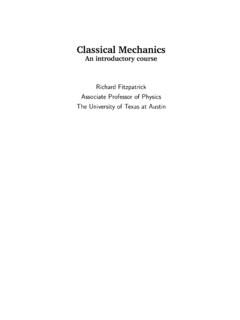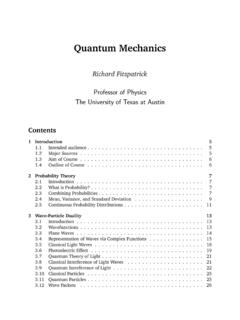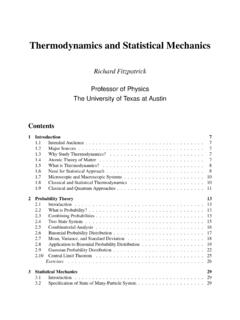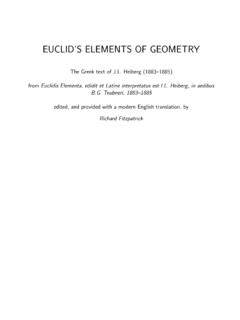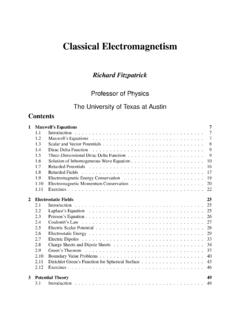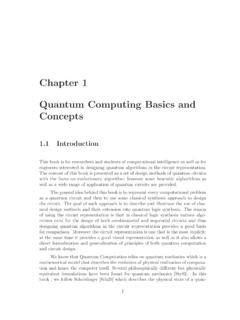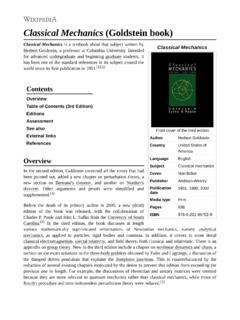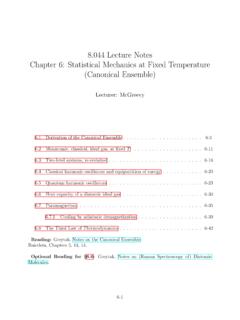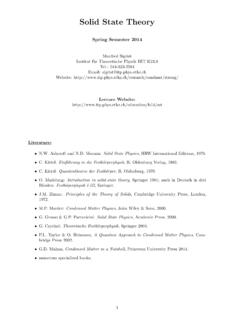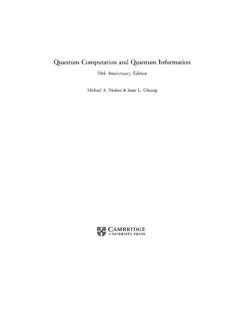Transcription of Quantum Mechanics - University of Texas at Austin
1 Quantum MechanicsRichard FitzpatrickProfessor of PhysicsThe University of Texas at AustinContents1 Intended audience .. Major Sources .. Aim of Course .. Outline of Course .. 62 Probability Introduction .. What is Probability? .. Combining Probabilities .. Mean, Variance, and Standard Deviation .. Continuous Probability Distributions .. 113 Wave-Particle Introduction .. Wavefunctions .. Plane Waves .. Representation of Waves via Complex Functions .. Classical Light Waves .. Photoelectric Effect .. Quantum Theory of Light .. Classical Interference of Light Waves.
2 Quantum Interference of Light .. Classical Particles .. Quantum Particles .. Wave Packets .. 262 Quantum Evolution of Wave Packets .. Heisenberg s Uncertainty Principle .. Schr odinger s Equation .. Collapse of the Wave Function .. 364 Fundamentals of Quantum Introduction .. Schr odinger s Equation .. Normalization of the Wavefunction .. Expectation Values and Variances .. Ehrenfest s Theorem .. Operators .. Momentum Representation .. Heisenberg s Uncertainty Principle .. Eigenstates and Eigenvalues .. Measurement .. Continuous Eigenvalues.
3 Stationary States .. 605 One-Dimensional Introduction .. Infinite Potential Well .. Square Potential Barrier .. WKB Approximation .. Cold Emission .. Alpha Decay .. Square Potential Well .. Simple Harmonic Oscillator .. 806 Multi-Particle Introduction .. Fundamental Concepts .. Non-Interacting Particles .. Two-Particle Systems .. Identical Particles .. 897 Three-Dimensional Quantum Introduction .. Fundamental Concepts .. Particle in a Box .. Degenerate Electron Gases .. White-Dwarf Stars ..100 CONTENTS38 Orbital Angular Introduction.
4 Angular Momentum Operators .. Representation of Angular Momentum .. Eigenstates of Angular Momentum .. Eigenvalues ofLz.. Eigenvalues ofL2.. Spherical Harmonics ..1109 Central Introduction .. Derivation of Radial Equation .. Infinite Spherical Potential Well .. Hydrogen Atom .. Rydberg Formula .. 12610 Spin Angular Introduction .. Spin Operators .. Spin Space .. Eigenstates ofSzandS2.. Pauli Representation .. Spin Precession ..13611 Addition of Angular Introduction .. General principles .. Angular Momentum in the Hydrogen Atom .. Two Spin One-Half Particles.
5 14712 Time-Independent Perturbation Introduction .. Improved Notation .. Two-State System .. Non-Degenerate Perturbation Theory .. Quadratic Stark Effect .. Degenerate Perturbation Theory .. Linear Stark Effect .. Fine Structure of Hydrogen .. Zeeman Effect .. Hyperfine Structure .. 17013 Time-Dependent Perturbation Theory1754 Quantum Introduction .. Preliminary Analysis .. Two-State System .. Spin Magnetic Resonance .. Perturbation Expansion .. Harmonic Perturbations .. Electromagnetic Radiation .. Electric Dipole Approximation .. Spontaneous Emission .. Radiation from a Harmonic Oscillator.
6 Selection Rules .. 1 STransitions in Hydrogen .. Intensity Rules .. Forbidden Transitions .. 19414 Variational Introduction .. Variational Principle .. Helium Atom .. Hydrogen Molecule Ion .. 20415 Scattering Introduction .. Fundamentals .. Born Approximation .. Partial Waves .. Determination of Phase-Shifts .. Hard Sphere Scattering .. Low Energy Scattering .. Resonances .. 220 Introduction51 Intended audienceThese lecture notes outline a single semester course onnon-relativistic Quantum mechanicswhich is primarily intended forupper-division undergraduate physics majors.
7 The courseassumes some previous knowledge of physics and mathematics. In particular, prospectivestudents should be reasonably familiar with Newtonian dynamics, elementary classicalelectromagnetism and special relativity, the physics and mathematics of waves (includ-ing the representation of waves via complex functions), basic probability theory, ordinaryand partial differential equations, linear algebra, vector algebra, and Fourier series Major SourcesThe textbooks which I have consulted most frequently whilstdeveloping course materialare:The principles of Quantum Mechanics , Dirac, 4th Edition (revised), (Oxford Univer-sity Press, Oxford UK, 1958).
8 Quantum Mechanics , E. Merzbacher, 2nd Edition, (John Wiley & Sons, New York NY,1970).Introduction to the Quantum Theory, D. Park, 2nd Edition, (McGraw-Hill, New York NY,1974).Modern Quantum Mechanics , Sakurai, (Benjamin/Cummings, Menlo Park CA, 1985). Quantum Theory, D. Bohm, (Dover, New York NY, 1989).Problems in Quantum Mechanics , Squires, (Cambridge University Press, CambridgeUK, 1995). Quantum Physics, S. Gasiorowicz, 2nd Edition, (John Wiley & Sons, New York NY, 1996).Nonclassical Physics, R. Harris, (Addison-Wesley, Menlo Park CA, 1998).Introduction to Quantum Mechanics , Griffiths, 2nd Edition, (Pearson Prentice Hall,Upper Saddle River NJ, 2005).
9 6 Quantum Aim of CourseThe aim of this course is to develop non-relativistic Quantum Mechanics as a completetheory of microscopic dynamics, capable of making detailedpredictions, with a minimumof abstract Outline of CourseThe first part of the course is devoted to an in-depth exploration of the basic principlesof Quantum Mechanics . After a brief review of probability theory, in Chapter 2, we shallstart, in Chapter 3, by examining how many of the central ideas of Quantum mechanicsare a direct consequence of wave-particle duality , the concept that waves sometimesact as particles, and particles as waves. We shall then proceed to investigate the rules ofquantum Mechanics in a more systematic fashion in Chapter Mechanics isused to examine the motion of a single particle in one dimension, many particles in onedimension, and a single particle in three dimensions, in Chapters 5, 6, and 7, 8 is devoted to the investigation of orbital angularmomentum, and Chapter 9 tothe closely related subject of particle motion in a central potential.
10 Finally, in Chapters 10and 11, we shall examine spin angular momentum, and the addition of orbital and spinangular momentum, second part of this course describes selected practicalapplications of quantummechanics. In Chapter 12, time-independent perturbation theory is used to investigate theStark effect, the Zeeman effect, fine structure, and hyperfine structure, in the hydrogenatom. Time-dependent perturbation theory is employed to study radiative transitions inthe hydrogen atom in Chapter 13. Chapter 14 illustrates the use of variational methods inquantum Mechanics . Finally, Chapter 15 contains an introduction to Quantum Theory72 Probability IntroductionThis section is devoted to a brief, and fairly low level, introduction to a branch of mathe-matics known asprobability What is Probability?
